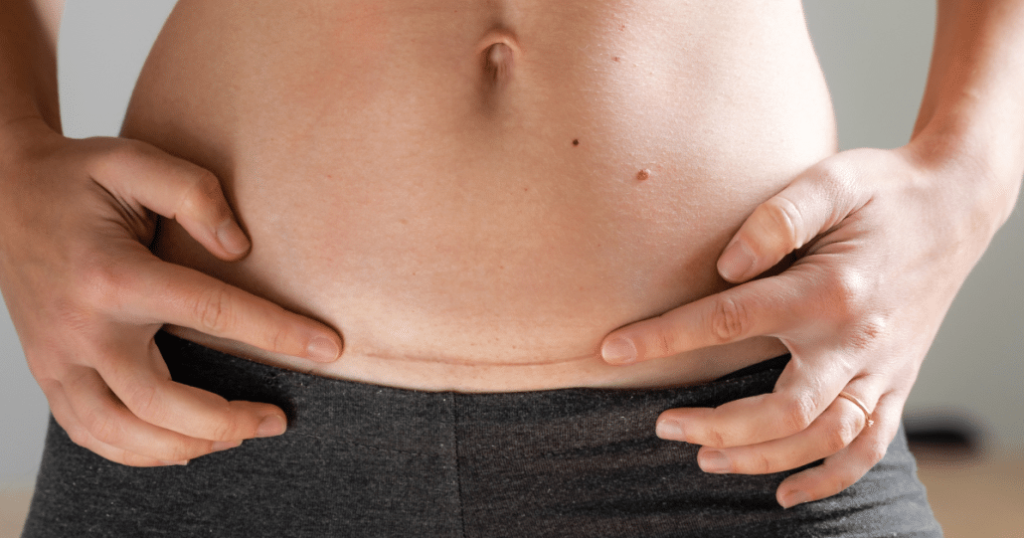Post-C-Section Recovery
Welcoming a new life into the world is a transformative experience, and for many mothers, a C-section becomes a part of this journey. While this surgical procedure ensures the safe delivery of the baby, it also brings with it a set of recovery challenges. As you navigate the postpartum phase, questions like “When can I start bending after a C-section?” or “How long should I wait before resuming regular activities?” might arise. This article aims to shed light on these concerns, offering insights and guidance to help you through this crucial recovery period.

Understanding the C-Section Procedure
A Cesarean section, commonly referred to as a C-section, is a surgical method used to deliver a baby. This procedure becomes necessary when vaginal delivery poses risks to the mother or the child. During a C-section, a medical practitioner makes incisions through the mother’s abdomen and uterus to safely extract the baby.
The process involves cutting through various layers, including the skin, fat, fascia, and the uterus itself. While the external incisions might seem small, the internal healing process is intricate. After the baby’s delivery, the top layers are sewn back together, allowing the deeper layers to heal naturally over time. This healing process is delicate, requiring mothers to be cautious and attentive to their body’s signals.
The Importance of Recovery Time
The body’s miraculous ability to heal is evident in the weeks following a C-section. However, this healing doesn’t happen overnight. Medical professionals typically recommend a recovery period of 4 to 6 weeks post-surgery. This time frame isn’t arbitrary; it’s grounded in the body’s natural healing process.
Bending or exerting pressure on the abdominal area too soon can jeopardize the healing process. The stitches or staples used to close the incision are at risk of rupturing, leading to complications. Moreover, bending can exert undue pressure on the abdominal area, causing pain and discomfort. Hence, it’s imperative to give your body the time it needs, to ensure a smooth and complication-free recovery.
Bending After a C-Section: The Do’s and Don’ts
Bending after a C-section might seem like a simple, everyday activity, but it requires special attention during the recovery phase. Here’s what you need to know:
- When to Start: It’s generally safe to start light bending after the first two weeks, but always listen to your body. If you feel any discomfort, it’s a sign to take things slow.
- The Correct Way: When you do start bending, ensure you use your knees and not your waist. This technique reduces the strain on your abdominal area, protecting the incision site.
- Avoid Heavy Lifting: For the first six weeks, refrain from lifting anything heavier than your baby. This precaution helps prevent undue pressure on the healing tissues.
Tips for New Moms: Bending Alternatives
While bending is a part of our daily routine, there are ways to minimize it, especially during the initial weeks post-surgery:
- Knee Bends: Instead of bending from the waist, try going down on one knee to pick up items. This method reduces strain on the abdomen.
- Seek Help: Don’t hesitate to ask family or friends for assistance with tasks that require bending or lifting.
- Use Tools: Consider using grabbing tools or extenders to pick up items from the floor without bending.
Signs of Complications to Watch Out For
As you navigate the post-C-section recovery, it’s essential to be aware of potential complications:
- Incision Site Issues: Regularly check the incision area for signs of infection, such as redness, swelling, or discharge. A foul odor or increased pain can also indicate complications.
- Internal Discomfort: Sharp pains, especially when bending or lifting, might suggest internal issues. It’s crucial to consult your healthcare provider if you experience such symptoms.
- General Health: Fever, chills, or prolonged fatigue are signs that your body might be fighting an infection. Always reach out to your doctor if you notice any of these symptoms.
The Role of Support Systems in Postpartum Care
Recovery after a C-section is not just a physical journey but an emotional one as well. Having a robust support system can make a world of difference:
- Emotional Support: Surrounding yourself with loved ones who understand and empathize with your experience can be comforting. They can provide a listening ear, words of encouragement, and much-needed companionship during this time.
- Physical Assistance: Whether it’s helping with household chores, taking care of the baby, or simply fetching things so you don’t have to bend, having someone to assist can be invaluable.
- Professional Guidance: Postpartum doulas or nurses can offer expert advice and hands-on assistance during the initial weeks, ensuring both the mother and baby are well taken care of.
Final Thoughts on Post-C-Section Care
A C-section is a significant medical procedure that demands time, patience, and care for recovery. While the anticipation of resuming regular activities is natural, it’s essential to prioritize healing. Every woman’s body is unique, and recovery rates can vary. Listening to your body, following medical advice, and seeking support can ensure a smooth transition into motherhood.
Remember, the postpartum phase, with all its challenges, is temporary. With time, care, and support, you’ll soon find yourself back to your routine, cherishing the joys of motherhood.




